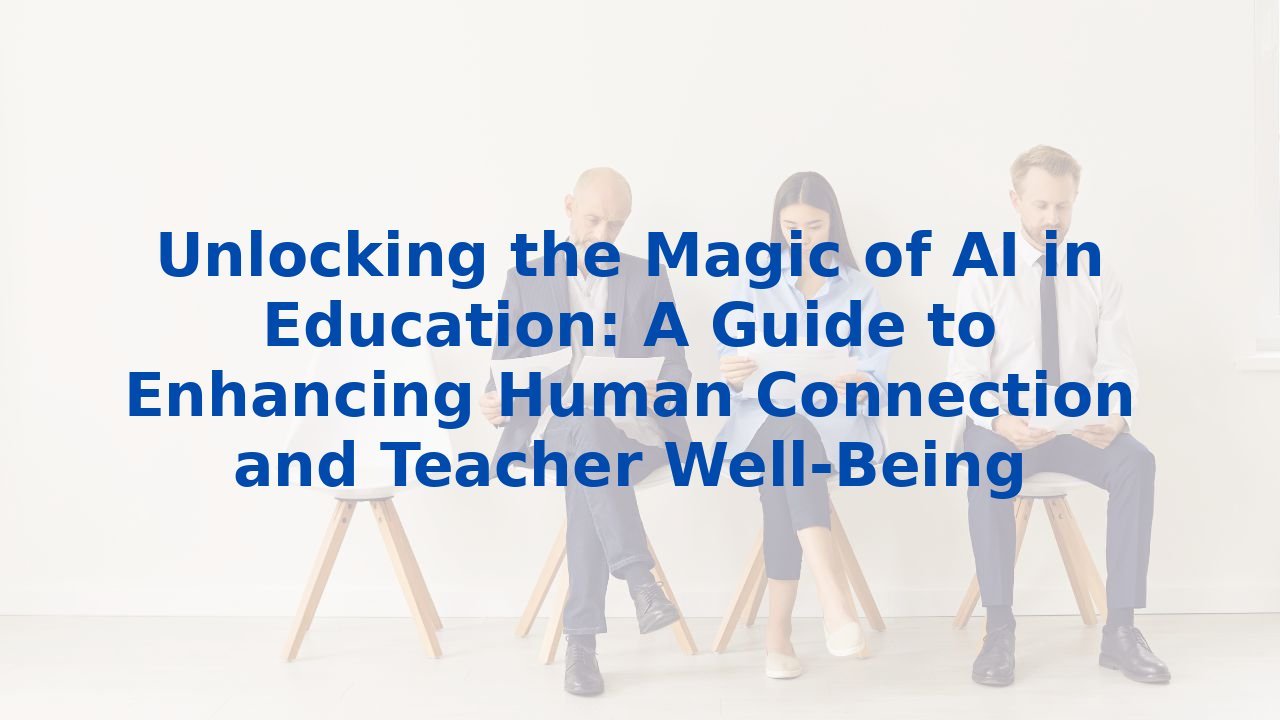Unlocking the Magic of AI in Education: A Guide to Enhancing Human Connection and Teacher Well-Being

Unlocking the Magic of AI in Education: A Guide to Enhancing Human Connection and Teacher Well-Being
In the ever-evolving landscape of education, the integration of Artificial Intelligence (AI) has emerged as a transformative force. While many might wonder about the magic behind AI, the true marvel is how it enriches our teaching practices, allowing educators to focus on what genuinely matters: building meaningful human connections and enhancing teacher well-being. This article delves into the multifaceted benefits of AI in education, explores its capacity to improve organizational efficiency, and highlights the pivotal role of training educators to fully harness its potential.
The Benefits of AI in Education
AI is reshaping the educational sector by introducing numerous advantages that optimize both teaching and learning environments.
1. Personalization of Learning
AI revolutionizes the learning experience by tailoring educational materials to meet the unique needs of each student. With the ability to adapt to different learning paces, AI facilitates personalized learning paths that empower students to strengthen their weaknesses while advancing in areas of strength. When educators embrace this technology, they create an inclusive atmosphere where every learner can thrive.
2. Administrative Efficiency
A significant advantage of AI lies in its capacity to streamline administrative operations. By automating routine tasks, such as grading, scheduling, and student enrollment, AI alleviates the administrative burden on educators. This newfound efficiency allows teachers to redirect their focus towards what they do best: engaging students and fostering a love for learning.
3. Enhanced Accessibility
AI serves as a powerful equalizer in education, providing high-quality resources to students, regardless of socioeconomic status or geographic location. For learners with disabilities, AI can drastically improve accessibility by offering digital textbooks with features such as sign-language videos and speech-to-text conversion. This inclusivity ensures that every student has the opportunity to succeed.
4. Continuous Assessment and Feedback
AI's capabilities extend to real-time progress tracking and assessment. It offers continuous feedback to students, helping them recognize their strengths and areas for growth. This method of real-time assessment not only enhances the learning experience but also fosters a growth mindset, where students feel supported in their educational journey.
The Importance of Training Educators
While AI presents countless benefits, its effective implementation hinges on the training and preparedness of educators. The following elements underscore the crucial need for well-trained teachers in our AI-enhanced classrooms.
1. Equipping Educators with AI Skills
Educators must be armed with the proper skills and knowledge to effectively leverage AI in their teaching practices. Training programs should not only focus on familiarizing teachers with AI tools but also emphasize the integration of these technologies into traditional methods, ensuring a harmonious blend between innovative resources and authentic human interaction.
2. Balancing Traditional Teaching with AI
Finding an equilibrium between traditional education and AI is vital for successful implementation. AI should complement, rather than supplant, human interactions. Teachers can utilize AI as an augmentation to their educational philosophies, emphasizing the importance of creating a classroom environment where technology serves as a tool for engagement, rather than a barrier to genuine connection.
3. Focusing on Ethics
Ethics are paramount when introducing AI into education. It’s essential that educational institutions prioritize student data protection and use technology responsibly. Attention must also be given to issues of bias, ensuring that AI tools promote inclusivity and fairness within the learning environment. This ethical framework fosters a stronger trust between educators, students, and technology.
Enhancing Efficiency and Human Connection
By harnessing AI to automate administrative responsibilities and generate personalized learning experiences, educators can reclaim invaluable time to concentrate on what truly matters: nurturing human connections and well-being.
1. Saving Time for Transformative Experiences
AI facilitates the mechanics of education, affording teachers the bandwidth to ignite curiosity and emotional intelligence in their classrooms. When educators can shift their focus from mundane tasks to transformative educational experiences, they create an environment where both learners and teachers feel seen, heard, and valued.
2. Promoting Digital Literacy and Critical Thinking
As AI reforms the assessment landscape, it helps cultivate essential skills like digital literacy, critical thinking, creativity, and problem-solving. These competencies are increasingly sought after in today's job market, and by integrating AI into educational practices, we prepare students for future success in an ever-changing world.
Conclusion
The integration of AI in education represents a profound paradigm shift, unlocking a myriad of benefits—from personalized learning to administrative efficiency. However, the successful implementation of these systems depends on well-trained educators who can harmonize technological advancements with human interactions. By emphasizing the importance of ethics, providing robust training programs, and leveraging AI to enhance educational practices, we can foster enriching experiences that prioritize human connection and well-being. As we navigate the immense potential of AI in education, we lay the foundation for a more efficient, engaging, and personalized learning environment for all.